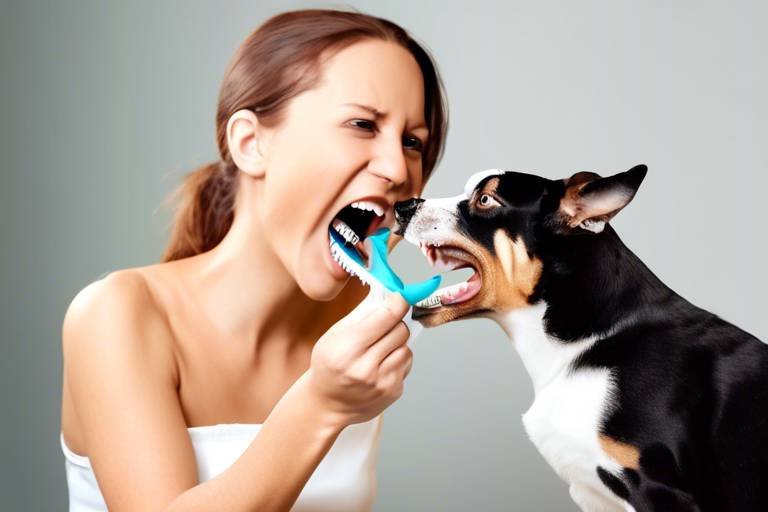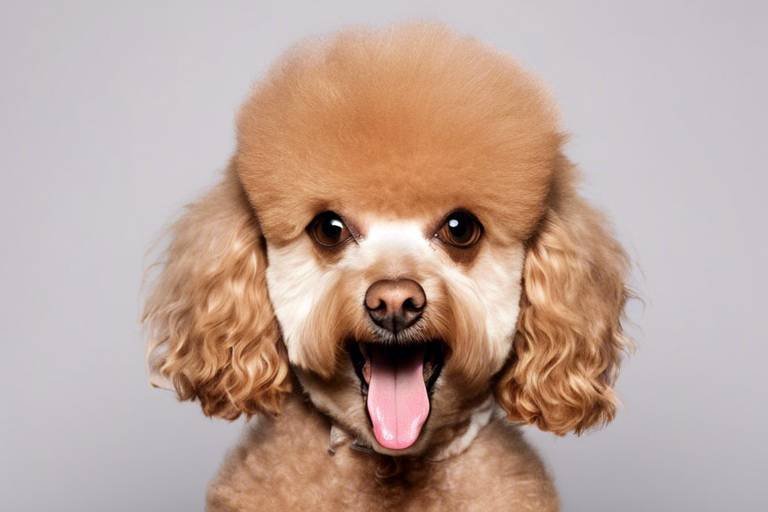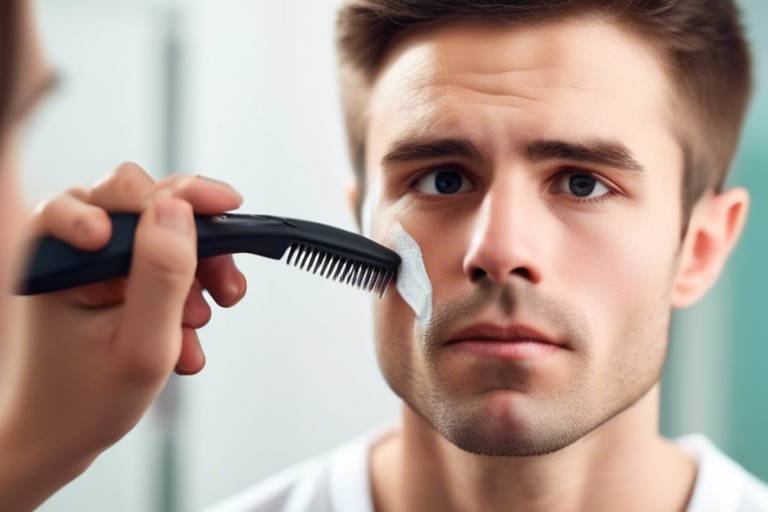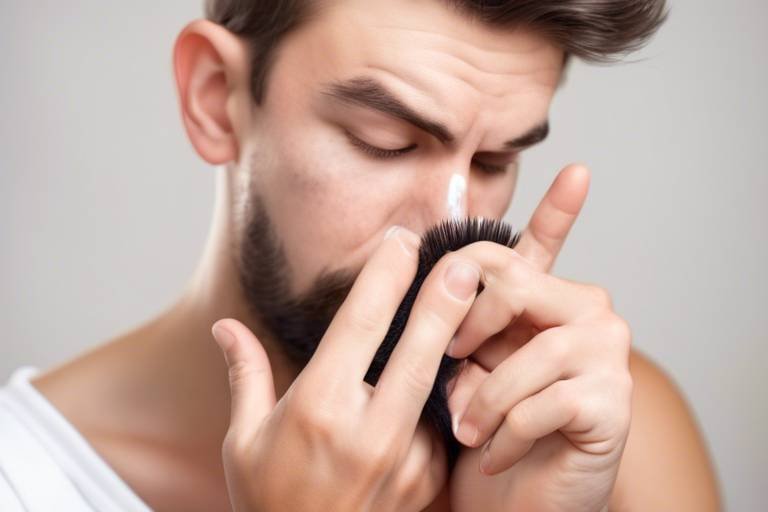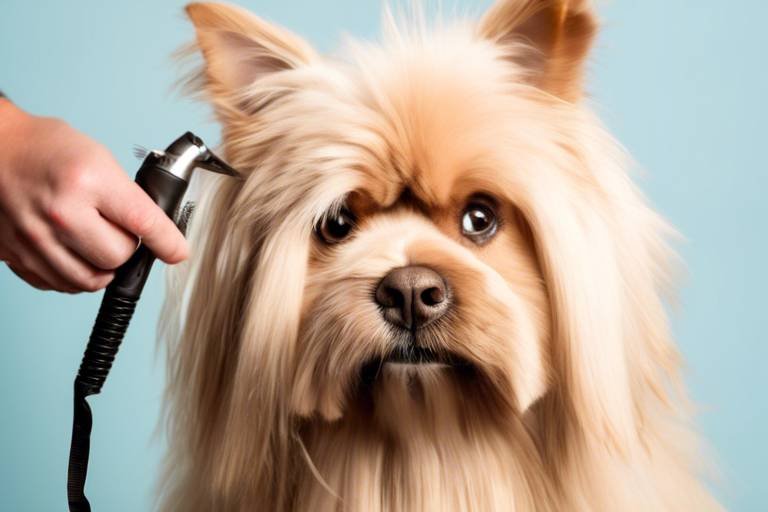The Role of Grooming in Preventing Health Issues
Grooming your pet is not just about making them look good; it’s a vital aspect of their overall health and well-being. Just like us, our furry friends need regular maintenance to ensure they stay happy and healthy. Imagine trying to function in a world where you’re constantly uncomfortable due to matted fur, dirty teeth, or untrimmed nails. It’s not just about aesthetics; it's about preventing health issues that can arise from neglect. Regular grooming practices can significantly reduce health risks for pets, improve their overall well-being, and enhance the bond between pets and their owners.
When we talk about grooming, we’re referring to a variety of practices that go beyond the occasional brush or bath. This includes everything from brushing their coat to trimming their nails and even taking care of their dental hygiene. Each of these practices plays a unique role in keeping your pet healthy. For instance, regular brushing helps to remove dirt, debris, and loose fur, while also distributing natural oils throughout their coat, which keeps it shiny and healthy. Regular baths can help to keep skin irritations at bay, ensuring your pet feels comfortable in their own skin.
But let’s not forget about the emotional aspect of grooming. Many pets actually enjoy the grooming process, and it can serve as a wonderful bonding experience between you and your pet. Think of it as a spa day for them! This shared time can reduce anxiety and improve their mood, making them feel loved and cared for. So, when you pick up that brush or nail clippers, remember that you’re not just maintaining their appearance; you’re also investing in their happiness.
Furthermore, the role of grooming in preventing health issues cannot be overstated. For example, regular grooming can help you spot potential health problems early on. During a grooming session, you may notice unusual lumps, bumps, or skin irritations that might require a vet’s attention. Detecting these issues early can make a significant difference in treatment outcomes. In essence, grooming acts as a preventative measure, allowing you to keep a close eye on your pet's health while also ensuring they look and feel their best.
In summary, grooming is an essential practice that goes far beyond mere appearances. It is a comprehensive approach to maintaining your pet’s health, happiness, and hygiene. By incorporating regular grooming into your pet care routine, you’re not just enhancing their physical appearance; you’re actively contributing to their overall quality of life. So, let’s dive deeper into the various benefits of regular grooming and explore how it can lead to a healthier, happier pet.

Understanding Grooming Basics
Grooming is often seen as a luxury or merely a way to keep pets looking good, but it’s so much more than that. Think of grooming as a comprehensive health check-up for your furry friend. Just like we visit the doctor for regular check-ups, our pets require consistent grooming to ensure they are healthy and happy. Grooming encompasses a variety of practices, including bathing, brushing, nail trimming, and ear cleaning, each serving a unique purpose in maintaining your pet's well-being.
When we talk about grooming, it’s essential to understand that it plays a crucial role in preventing health issues. Regular grooming helps to remove dirt, debris, and loose fur, which can otherwise lead to skin irritations or infections. Additionally, it allows pet owners to spot potential health problems early on, such as lumps, bumps, or skin conditions. By incorporating grooming into your pet care routine, you are not just enhancing their appearance but also safeguarding their health.
Moreover, grooming is an excellent opportunity for bonding between pets and their owners. Imagine the trust and comfort your pet feels when you gently brush their fur or give them a bath. It’s a moment of connection that can strengthen your relationship. Grooming can also be a relaxing experience for pets, reducing their stress levels and promoting a sense of calm. This makes grooming not only a health necessity but also a delightful ritual that both you and your pet can enjoy.
In summary, understanding the basics of grooming goes beyond aesthetics. It’s about ensuring your pet's health, happiness, and overall quality of life. As we delve deeper into the benefits and techniques of grooming, remember that every brushstroke and bath contributes to your pet’s well-being.
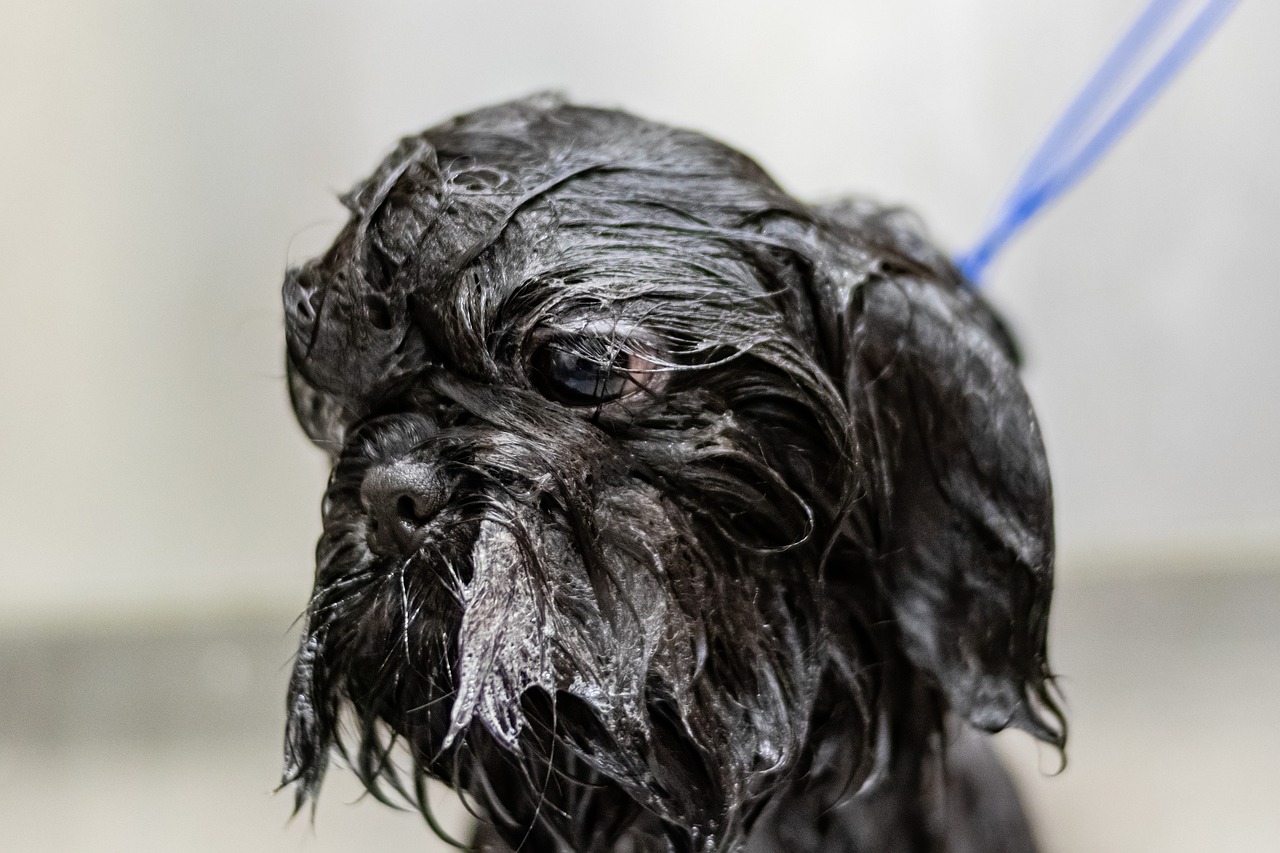
Benefits of Regular Grooming
When it comes to our furry companions, grooming is often viewed as a luxury rather than a necessity. However, the truth is that regular grooming is essential for maintaining not only a pet's appearance but also their overall health and happiness. Think of grooming as a health check-up, but one that is enjoyable and bonding for both pets and their owners. Just like we feel fresh and rejuvenated after a good shower, pets benefit immensely from their grooming routines.
One of the most significant benefits of regular grooming is improved hygiene. A well-groomed pet is less likely to suffer from issues like skin infections or flea infestations. Regular brushing removes dirt, debris, and loose fur, which can harbor allergens and irritants. This is especially important for pets with long or thick fur, as matting can lead to painful skin conditions. Additionally, a clean coat helps to regulate body temperature, keeping pets comfortable in various weather conditions.
Moreover, grooming serves as an excellent opportunity for early detection of health issues. During grooming sessions, pet owners can spot unusual bumps, lumps, or changes in skin condition that may indicate underlying health problems. This proactive approach can lead to early veterinary intervention, which is often crucial in ensuring the best outcomes for our pets. For instance, a small, seemingly harmless growth could be a sign of something more serious, and catching it early can make a world of difference.
Beyond physical health, grooming has profound emotional and behavioral benefits. Many pets find grooming to be a soothing experience, akin to a spa day. Regular grooming can help reduce anxiety and stress, making pets feel more secure and happy. Imagine how you feel after a relaxing massage or a day at the spa; pets experience similar feelings of comfort and relaxation during grooming sessions. This positive experience can lead to better behavior, as well-groomed pets are often more calm and sociable.
To illustrate the multiple benefits of regular grooming, here’s a quick overview:
| Benefit | Description |
|---|---|
| Improved Hygiene | Regular grooming removes dirt and debris, reducing the risk of infections. |
| Early Detection of Health Issues | Grooming allows owners to notice changes in their pet's skin and coat. |
| Emotional Well-being | Grooming can be a calming experience, reducing anxiety in pets. |
| Better Bonding | Regular grooming sessions strengthen the bond between pet and owner. |
In conclusion, the benefits of regular grooming extend far beyond aesthetics. It is a vital practice that promotes hygiene, facilitates early health detection, and enhances the emotional well-being of pets. So, the next time you think about skipping that grooming session, remember that you’re not just brushing fur; you’re investing in your pet’s health and happiness.
Q: How often should I groom my pet?
A: The frequency of grooming depends on the type of pet and their coat. Long-haired breeds may require grooming several times a week, while short-haired pets may only need grooming once a month.
Q: Can I groom my pet at home?
A: Yes, many grooming tasks can be done at home. However, some services, like professional nail trimming or specific haircuts, may require a groomer’s expertise.
Q: What tools do I need for grooming?
A: Basic grooming tools include brushes, combs, nail clippers, and pet-safe shampoo. The specific tools may vary based on your pet's needs.
Physical Health Benefits
When we talk about grooming our pets, it's easy to think of it as a mere beauty routine. However, the truth is that grooming is a vital part of maintaining your pet's physical health. Just like how a well-maintained car runs better, a well-groomed pet feels better. Regular grooming can prevent a host of health issues that can arise from neglect. For instance, matting of fur can trap dirt and moisture, leading to skin infections that are both painful and costly to treat. By keeping your pet's coat clean and tangle-free, you significantly reduce the risk of such problems.
Moreover, grooming promotes better circulation. When you brush your pet's coat, you're not just removing loose hairs; you're also stimulating the skin and blood flow underneath. This increased circulation can lead to healthier skin and a shinier coat, which are indicators of overall well-being. Think of it as a mini massage for your furry friend! It's not just about looking good; it's about feeling good too.
In addition to skin and coat health, grooming helps in the early detection of health issues. As you brush or bathe your pet, you have the opportunity to check for unusual lumps, bumps, or skin irritations. This proactive approach means that you can catch potential health problems before they escalate into something more serious. For example, noticing a small growth during grooming can lead to timely veterinary care, potentially saving your pet from more severe complications down the line.
Another often-overlooked aspect is the role of grooming in preventing parasites. Regular brushing can help you spot fleas, ticks, or other pests that might be hiding in your pet's fur. The sooner you detect these nuisances, the quicker you can act to eliminate them, ensuring your pet remains comfortable and healthy.
To summarize, the physical health benefits of grooming are extensive and vital for your pet's well-being. Here’s a quick overview:
| Benefit | Description |
|---|---|
| Prevention of Matting | Reduces the risk of skin infections and discomfort. |
| Improved Circulation | Stimulates blood flow, leading to healthier skin and coat. |
| Early Detection of Health Issues | Allows for timely veterinary intervention, preventing serious problems. |
| Parasite Control | Helps in identifying and eliminating fleas and ticks. |
In conclusion, grooming is not just about aesthetics. It's a fundamental practice that can lead to a healthier, happier pet. By investing time in regular grooming, you are not only enhancing your pet's appearance but also enriching their quality of life. So, the next time you grab that brush or comb, remember that you are doing so much more than just keeping your pet looking fabulous!
Skin and Coat Health
When it comes to our furry friends, a healthy skin and coat are often the first indicators of overall well-being. Grooming is not just about making your pet look good; it plays a vital role in maintaining their skin and coat health. Regular grooming helps to remove dirt, debris, and loose fur, which can otherwise lead to skin irritations and infections. Imagine your pet’s coat like a beautiful tapestry; if it’s not regularly cleaned and maintained, it can become matted and frayed, losing its luster and protective qualities.
Furthermore, grooming stimulates the skin’s natural oils, which help to keep the coat shiny and healthy. These oils act as a natural barrier against environmental factors such as dirt and allergens. By regularly brushing your pet, you’re not only enhancing their appearance but also promoting better skin hydration and elasticity. This is particularly important for breeds with long or thick fur that are prone to matting and tangles.
Let’s not forget the importance of regular bathing. While it might seem counterintuitive to wash away those natural oils, the right bathing routine—using appropriate shampoos and conditioners—can actually help maintain a healthy coat. It's crucial to choose products that are specifically formulated for pets, as human shampoos can strip away essential oils and lead to dryness or irritation. Here’s a quick overview of how grooming impacts skin and coat health:
| Grooming Technique | Benefits |
|---|---|
| Brushing | Removes loose fur, dirt, and debris; stimulates oil production. |
| Bathing | Removes allergens and dirt; keeps skin hydrated with proper products. |
| Regular Check-Ups | Early detection of skin issues like rashes or infections. |
In addition to physical grooming, you should also keep an eye on your pet’s diet, as nutrition plays a crucial role in skin and coat health. A balanced diet rich in omega fatty acids can significantly enhance the shine and texture of your pet's coat while also supporting skin health. Think of it as fueling a car; the better the fuel, the better the performance. So, by providing your pet with high-quality food, you’re not just grooming them on the outside, but you’re also nurturing them from within.
Ultimately, maintaining your pet’s skin and coat health through regular grooming creates a strong bond between you and your furry companion. The time spent grooming is not just a chore; it’s an opportunity to connect, check for any unusual lumps or bumps, and ensure that your pet feels loved and cared for. So, the next time you pick up that brush or comb, remember that you’re not just making your pet look fabulous—you’re contributing to their overall health and happiness!
- How often should I groom my pet? It depends on the breed and coat type, but generally, regular grooming every few weeks is recommended.
- What tools do I need for grooming? Basic tools include brushes, combs, nail clippers, and pet-safe shampoos.
- Can grooming help with shedding? Yes, regular grooming can significantly reduce shedding by removing loose fur.
Dental Care Importance
When it comes to our furry friends, oral hygiene is often an overlooked aspect of their overall health. Just like humans, pets can suffer from a variety of dental issues if their teeth and gums are not properly cared for. Regular dental care is essential not only for maintaining a fresh breath but also for preventing serious health problems. If you think about it, a pet's mouth is a gateway to its body; poor dental hygiene can lead to bacteria entering the bloodstream, potentially affecting vital organs like the heart, liver, and kidneys. Isn't that a scary thought?
So, what does proper dental care entail? It involves more than just the occasional brushing. Here are some key components to keep in mind:
- Daily Brushing: Just like you brush your teeth every day, your pet needs the same attention. Using a toothbrush designed for pets and toothpaste specifically formulated for them can make this task easier and more effective.
- Regular Check-ups: Routine veterinary check-ups can help identify any dental issues early on. Your vet can perform professional cleanings and check for signs of periodontal disease, which is common in pets.
- Dental Chews and Toys: Providing your pet with dental chews and toys can help reduce plaque and tartar buildup. These products are designed to promote chewing, which naturally cleans teeth.
Neglecting dental care can lead to a host of problems, including:
| Dental Issue | Potential Health Risks |
|---|---|
| Periodontal Disease | Can lead to tooth loss and infections. |
| Tooth Decay | May cause pain and difficulty eating. |
| Bad Breath | Often a sign of underlying dental issues. |
Moreover, maintaining your pet's dental health can significantly enhance their quality of life. Just imagine your dog or cat feeling comfortable and pain-free while eating their favorite treats. Regular dental care not only prevents discomfort but also contributes to your pet's overall happiness and well-being. After all, a healthy pet is a happy pet!
In conclusion, dental care is a vital part of grooming that should never be neglected. By incorporating regular brushing, professional check-ups, and dental-friendly products into your pet's routine, you're investing in their health and happiness. So, let's make sure our pets flash their brightest smiles!
Q: How often should I brush my pet's teeth?
A: Ideally, you should brush your pet's teeth daily. However, even a few times a week can significantly improve their dental health.
Q: Are dental treats effective?
A: Yes, dental treats can help reduce plaque and tartar buildup, but they should not replace regular brushing and professional cleanings.
Q: What are the signs of dental problems in pets?
A: Common signs include bad breath, difficulty eating, swollen gums, and excessive drooling. If you notice any of these symptoms, consult your veterinarian.
Emotional and Behavioral Benefits
Grooming is not just about keeping your pet looking fabulous; it plays a vital role in their emotional and behavioral health as well. Think of grooming as a form of bonding time between you and your furry friend. Just like humans feel relaxed and connected after a good massage or spa day, pets experience similar benefits during grooming sessions. When you take the time to groom your pet, you’re not only enhancing their appearance but also fostering a sense of security and trust. This connection can lead to a happier, more well-adjusted pet.
One of the most significant emotional benefits of regular grooming is the reduction of anxiety and stress. Many pets can become nervous or agitated in unfamiliar environments, but a familiar grooming routine can provide comfort. The act of brushing or bathing can be soothing, almost like a gentle hug. It’s during these moments that pets feel safe and cared for, which can significantly improve their overall mood. Furthermore, grooming can help reduce behavioral issues such as excessive barking or destructive chewing, as a calm pet is less likely to engage in these negative behaviors.
Moreover, grooming can serve as a preventive measure against behavioral problems. When pets are clean and comfortable, they are less likely to scratch, bite, or exhibit signs of discomfort. Regular grooming helps to identify any potential issues early on, such as skin irritations or ear infections, which can cause pain and lead to behavioral changes. By addressing these health concerns promptly, you can maintain not only your pet’s physical health but also their emotional well-being.
It's interesting to note that pets thrive on routine. Establishing a regular grooming schedule can create a sense of predictability in their lives, which is essential for their mental health. When pets know what to expect, they tend to feel more secure and confident. This routine can be particularly beneficial for younger pets or those who have experienced trauma, as it helps them adjust and feel at ease in their environment. Ultimately, regular grooming becomes a ritual that strengthens the bond between you and your pet, leading to a happier, more balanced relationship.
In summary, the emotional and behavioral benefits of grooming can be profound. By integrating grooming into your pet care routine, you’re not just enhancing their physical appearance; you’re also nurturing their emotional health. So, the next time you pick up that brush or clippers, remember that you’re doing so much more than just grooming—you're enriching your pet's life.
- How often should I groom my pet? The frequency of grooming depends on your pet's breed, coat type, and individual needs. Generally, long-haired breeds require more frequent grooming than short-haired ones.
- Can grooming help with my pet's anxiety? Yes, regular grooming can provide comfort and reduce anxiety in pets, as it creates a routine and strengthens the bond between you and your pet.
- What tools do I need for grooming? Basic grooming tools include brushes, combs, nail clippers, and shampoo. The specific tools may vary depending on your pet's coat type.
- Is it necessary to take my pet to a professional groomer? While many pet owners can handle basic grooming at home, professional groomers can help with more complex grooming needs and ensure your pet's overall health.

Common Grooming Techniques
When it comes to keeping our furry friends healthy and happy, grooming is an essential part of the equation. But what exactly does grooming entail? It’s not just about making your pet look good for Instagram; it’s about ensuring their well-being. There are several that every pet owner should know, and each serves a unique purpose in maintaining your pet's health.
First up, we have bathing. Regular baths help to remove dirt, allergens, and loose fur from your pet’s coat. But it’s not just about cleanliness; bathing can also prevent skin irritations and infections. Depending on your pet's breed and lifestyle, the frequency of baths can vary. For instance, a dog that loves to roll in the mud may require more frequent baths than a cat that prefers the indoors. The right shampoo can make all the difference, so always opt for products that are specifically designed for pets, as human shampoos can disrupt their skin's natural balance.
Next, let’s talk about brushing. This is a grooming technique that should not be overlooked. Regular brushing helps to reduce shedding and prevents matting, which can lead to painful skin issues. Different breeds require different types of brushes; for instance, long-haired breeds benefit from slicker brushes, while short-haired breeds may only need a bristle brush. The act of brushing also provides an opportunity to check for any unusual lumps, bumps, or skin irritations that may need veterinary attention. So, it’s not just about keeping your pet looking fabulous; it’s also a way to monitor their health on a regular basis.
Another often-neglected aspect of grooming is nail trimming. Overgrown nails can lead to discomfort and even mobility issues for your pet. If you’ve ever heard the sound of your pet’s claws clicking on the floor, it’s probably time for a trim. Regular nail care keeps your pet comfortable and prevents painful breaks or tears. If you’re unsure about how to trim your pet’s nails, don’t hesitate to ask your vet or a professional groomer for guidance.
Let’s not forget about ear cleaning. This is an important grooming technique that can prevent ear infections, especially in breeds with floppy ears. A simple wipe with a vet-approved cleaner can help keep your pet's ears free from wax buildup and debris. It’s a quick process that can save you from more serious health issues down the line. Remember, if you notice any unusual odors or discharge, it’s best to consult your veterinarian.
In summary, grooming is a multi-faceted approach to pet care that goes beyond aesthetics. Each technique, whether it’s bathing, brushing, nail trimming, or ear cleaning, plays a vital role in maintaining your pet’s health and happiness. By incorporating these grooming practices into your routine, you’re not just keeping your pet looking good; you’re also enhancing their overall quality of life. So, grab those grooming tools and make it a regular part of your bonding time with your furry friend!
- How often should I groom my pet? - The frequency of grooming depends on the breed and coat type. Long-haired breeds may need grooming several times a week, while short-haired breeds might only need it once a month.
- Can I use human shampoo on my pet? - No, human shampoos can disrupt the natural oils in your pet's skin. Always use pet-specific grooming products.
- What are the signs that my pet needs grooming? - Look for excessive shedding, matting, bad odors, or visible dirt on their coat as signs that your pet needs grooming.
- Is grooming painful for pets? - When done correctly, grooming should not be painful. If your pet seems uncomfortable, consult a professional groomer.
Bathing and Brushing
When it comes to keeping our furry friends healthy and happy, bathing and brushing are two of the most essential grooming practices that pet owners should prioritize. It's not just about making them look good; these activities play a pivotal role in maintaining their overall health and well-being. Think of bathing as a refreshing shower after a long day at the park, washing away dirt and grime, while brushing is akin to a relaxing massage that stimulates the skin and promotes a shiny coat. Together, they form a powerful duo in the grooming routine.
Bathing your pet regularly helps to remove dirt, allergens, and excess oils from their skin and coat. This is especially important for pets that spend a lot of time outdoors or have skin conditions that require special attention. Using the right shampoo is crucial; always opt for products specifically formulated for pets to avoid skin irritations. A good rule of thumb is to bathe your dog or cat every four to six weeks, but this can vary depending on their breed, lifestyle, and skin type. For instance, long-haired breeds may require more frequent baths compared to short-haired ones due to their propensity for tangling and matting.
On the other hand, brushing is equally important and should be done more frequently, ideally several times a week or even daily for some breeds. Regular brushing helps to remove loose fur, dirt, and debris while distributing natural oils throughout the coat, which keeps it healthy and shiny. It also serves as an opportunity to check for any unusual lumps, bumps, or skin irritations that may require veterinary attention. For example, a simple brushing session can reveal a hidden tick or flea infestation that might otherwise go unnoticed until it becomes a bigger problem.
Different breeds may require different types of brushes. Here’s a quick overview:
| Breed Type | Recommended Brush Type |
|---|---|
| Short-haired | Slicker brush or rubber curry brush |
| Medium-haired | Pin brush or bristle brush |
| Long-haired | Wide-toothed comb or rake |
In conclusion, incorporating regular bathing and brushing into your pet's grooming routine is not just about aesthetics; it's a vital component of their health care. By staying consistent with these practices, you’ll not only keep your pet looking fabulous but also contribute significantly to their physical and emotional well-being. So, next time you schedule a grooming session, remember that you're doing much more than just pampering your furry companion; you're investing in their health and happiness.
- How often should I bathe my pet? It typically depends on the breed and lifestyle, but every four to six weeks is a good starting point for most pets.
- What type of shampoo should I use? Always choose shampoos specifically formulated for pets to avoid skin irritations.
- How can I make brushing easier for my pet? Start slowly and make it a positive experience with treats and praise, gradually increasing the duration as they become more comfortable.
Nail Trimming and Ear Cleaning
Nail trimming and ear cleaning are often overlooked aspects of pet grooming, yet they play a vital role in ensuring your furry friend's overall health and comfort. Just like we regularly trim our nails and clean our ears, our pets need the same care to avoid potential health issues. Imagine if you never cut your nails; they would grow long and could become painful or even lead to infections. The same principle applies to your pets. Regular nail trimming prevents discomfort and mobility issues, as long nails can cause pain when walking and even lead to joint problems over time.
When it comes to ear cleaning, many pet owners might not realize that a buildup of wax and dirt can lead to serious infections. Just like a clogged drain can cause water to back up, dirty ears can result in a host of problems for your pet. Routine ear cleaning can help you identify any unusual odors or discharge early on, which might indicate an underlying issue that requires veterinary attention. It's essential to use appropriate cleaning solutions and techniques to ensure you're not causing harm. For example, using cotton balls or pads with a vet-recommended solution can help keep your pet's ears clean without damaging the delicate inner structures.
Here are some key points to remember about nail trimming and ear cleaning:
- Frequency: Nail trimming should be done every 3-4 weeks, while ear cleaning can be done every 1-2 weeks, depending on your pet's breed and activity level.
- Tools: Use specialized pet nail clippers and ear cleaning solutions to ensure safety and effectiveness.
- Signs of Issues: Look out for signs of discomfort in your pet, such as excessive scratching, head shaking, or reluctance to walk, which may indicate that it's time for a grooming session.
Incorporating these grooming practices into your pet care routine not only helps prevent health complications but also strengthens the bond between you and your pet. They will come to associate grooming with positive experiences, making it easier for you to maintain their health and happiness.
Q: How often should I trim my pet's nails?
A: Ideally, you should trim your pet's nails every 3-4 weeks. However, the frequency may vary based on your pet's activity level and the surfaces they walk on.
Q: What signs indicate my pet needs ear cleaning?
A: If you notice a foul odor, excessive scratching at the ears, or discharge, it's time to clean your pet's ears or consult your vet.
Q: Can I use human nail clippers for my pet?
A: It's best to use pet-specific nail clippers, as they are designed to make the process safer and more comfortable for your pet.
Q: Is ear cleaning painful for pets?
A: When done correctly, ear cleaning should not be painful. Always use gentle techniques and consult your vet for the best practices.
Frequently Asked Questions
- Why is grooming important for my pet's health?
Grooming is essential for maintaining your pet's health because it helps prevent skin infections, matting, and other physical issues. Regular grooming also allows you to spot potential health problems early, which can lead to quicker treatment and better outcomes.
- How often should I groom my pet?
The frequency of grooming depends on your pet's breed, coat type, and lifestyle. Generally, dogs with long or thick coats may need grooming every few weeks, while short-haired pets might require less frequent grooming. Always consult your vet or a professional groomer for personalized advice.
- What are the benefits of regular brushing?
Regular brushing helps remove loose fur, dirt, and debris from your pet's coat, promoting a healthy and shiny appearance. It also stimulates the skin, improving circulation and reducing the risk of skin irritations. Plus, it’s a great bonding experience between you and your pet!
- How can grooming improve my pet's emotional well-being?
Grooming can significantly enhance your pet's emotional health by providing comfort and relaxation. The process can reduce anxiety and stress, making your pet feel secure and loved. Regular grooming sessions can also help establish a routine, which pets often find reassuring.
- What grooming tools do I need for my pet?
Essential grooming tools typically include brushes, combs, nail clippers, and pet-safe shampoos. Depending on your pet’s needs, you might also want to invest in ear cleaners and dental care products. Always choose tools that are appropriate for your pet's size and coat type.
- Can I groom my pet at home?
Absolutely! Many grooming tasks can be done at home, such as brushing, bathing, and nail trimming. However, for more complex grooming needs or if you’re unsure, it’s best to consult a professional groomer. They can also show you techniques to make grooming easier.
- What should I do if my pet resists grooming?
If your pet is resistant to grooming, try to make the experience more enjoyable by using treats and positive reinforcement. Start with short sessions and gradually increase the duration. Patience is key—over time, your pet may learn to associate grooming with positive experiences.
- Is grooming the same for all types of pets?
No, grooming varies significantly among different types of pets. For instance, dogs and cats have unique grooming needs based on their fur types, while small animals like rabbits or guinea pigs may require different care. Always research the specific grooming requirements for your pet.









